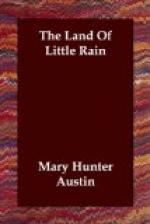WATER TRAILS OF THE CERISO
By the end of the dry season the water trails of the Ceriso are worn to a white ribbon in the leaning grass, spread out faint and fanwise toward the homes of gopher and ground rat and squirrel. But however faint to man-sight, they are sufficiently plain to the furred and feathered folk who travel them. Getting down to the eye level of rat and squirrel kind, one perceives what might easily be wide and winding roads to us if they occurred in thick plantations of trees three times the height of a man. It needs but a slender thread of barrenness to make a mouse trail in the forest of the sod. To the little people the water trails are as country roads, with scents as signboards.
It seems that man-height is the least fortunate of all heights from which to study trails. It is better to go up the front of some tall hill, say the spur of Black Mountain, looking back and down across the hollow of the Ceriso. Strange how long the soil keeps the impression of any continuous treading, even after grass has overgrown it. Twenty years since, a brief heyday of mining at Black Mountain made a stage road across the Ceriso, yet the parallel lines that are the wheel traces show from the height dark and well defined. Afoot in the Ceriso one looks in vain for any sign of it. So all the paths that wild creatures use going down to the Lone Tree Spring are mapped out whitely from this level, which is also the level of the hawks.
There is little water in the Ceriso at the best of times, and that little brackish and smelling vilely, but by a lone juniper where the rim of the Ceriso breaks away to the lower country, there is a perpetual rill of fresh sweet drink in the midst of lush grass and watercress. In the dry season there is no water else for a man’s long journey of a day. East to the foot of Black Mountain, and north and south without counting, are the burrows of small rodents, rat and squirrel kind. Under the sage are the shallow forms of the jackrabbits, and in the dry banks of washes, and among the strewn fragments of black rock, lairs of bobcat, fox, and coyote.
The coyote is your true water-witch, one who snuffs and paws, snuffs and paws again at the smallest spot of moisture-scented earth until he has freed the blind water from the soil. Many water-holes are no more than this detected by the lean hobo of the hills in localities where not even an Indian would look for it. It is the opinion of many wise and busy people that the hill-folk pass the ten-month interval between the end and renewal of winter rains, with no drink; but your true idler, with days and nights to spend beside the water trails, will not subscribe to it. The trails begin, as I said, very far back in the Ceriso, faintly, and converge in one span broad, white, hard-trodden way in the gully of the spring. And why trails if there are no travelers in that direction?




